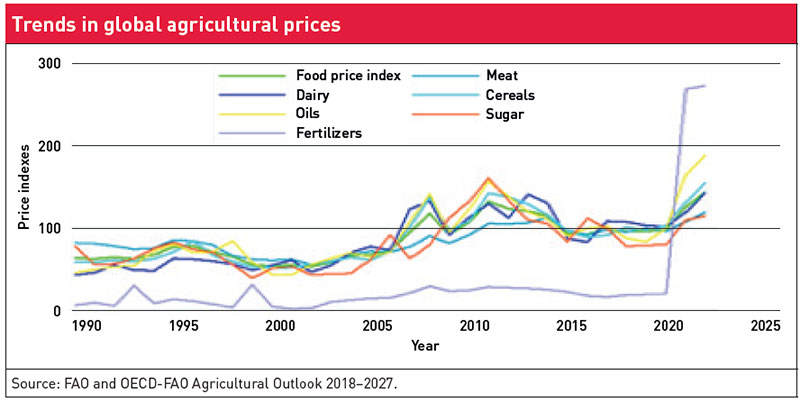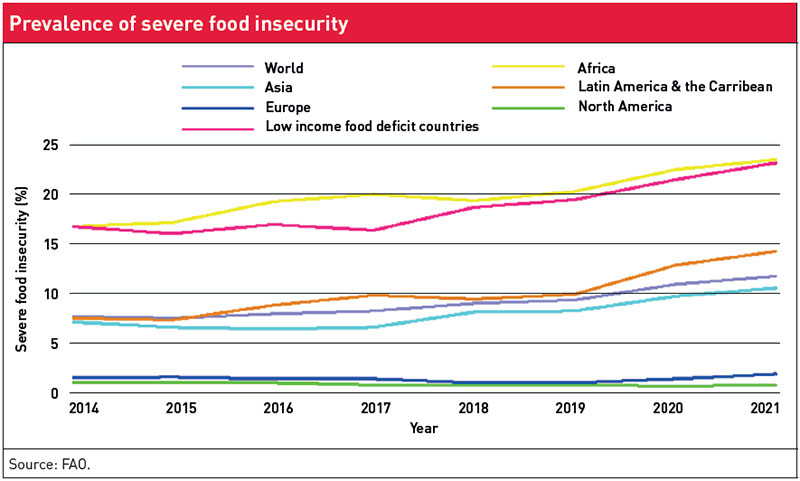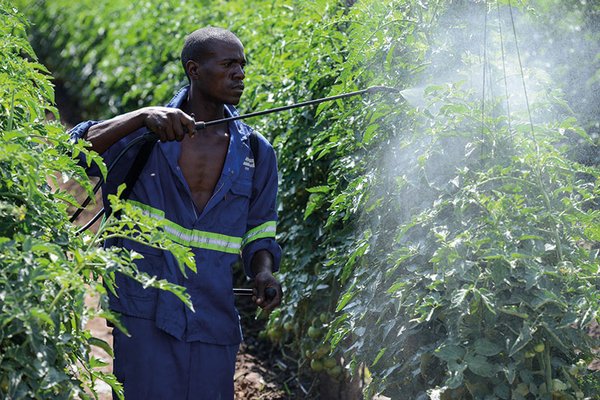Agricultural prices and food security – a complex relationship
Agricultural prices are pertinent tools in supply chains with an edging impact on food security. Rising agricultural prices – inputs and food alike – push more people into the poverty trap and food insecurity. This is evidenced by the Covid-19 pandemic and the Russia-Ukraine crisis, in which prices skyrocketed and became volatile particularly during the early period of the latter crisis, with a resultant effect on food security in many parts of the globe, especially in developing countries. Yet the implications of changes in agricultural prices on the populace are heterogeneous, affecting consumers, producers, income earners and regions differently, depending on their social capital and on aspects such as social insurance, preparedness and resilience. Thus, this article divulges into the pattern of global agricultural prices, their benefits and the challenges to food security.
Price transmission of food and input prices
Higher global agricultural prices can transmit to domestic prices, where the consumers and producers act as price takers. Their behaviour, the level of domestic markets’ integration into the global economy, trade policies, exchange rates, trade costs and consumer/producers’ price controls, among others, will determine the corresponding domestic prices. In addition, the responsiveness of domestic prices to international prices would be aggregated for net food importers, which many African countries are. This makes them more susceptible to international price shocks due to high import dependency and low domestic food sufficiency. Such price transmission is seen with the Russian-Ukraine and global financial crises, which have pushed more households into poverty and malnutrition, reduced income and escalated food insecurity for countries, especially for net importing ones. Besides, nationally, spatial price transmission is observed from one food market to another in the face of national conflicts and climate-induced drought or rain, which put constraints on food prices and agricultural production. Nonetheless, price transmission varies across commodities and markets – for instance, oilseeds and cereals have been shown to have more globalised markets than meat products. Prices have been volatile, as is evident in the upper Figure, which depicts oscillating nominal food and input prices with prominent spikes during crises such as those in 2007/08 and 2011 and the recent Covid-19 and Russian-Ukraine crises which have led to supply disruption and hikes in food prices.
Consequences of high agricultural prices
Rising agricultural prices increase food production costs and reduce productivity, which puts pressure on food prices and food security. However, high agricultural price levels have their pros and cons for producers and consumers. For consumers, rising food prices usually result in a fall in the preferred food and the number of meals consumed, leading to wider food insecurity gaps for both urban and rural populations, particularly for the (urban) poor, who are majorly net food consumers. In addition, high agricultural prices, especially food prices, decrease net income and purchasing power, and they might lead to lower calorie intake or dietary diversity as consumers adjust their consumption patterns to rising prices. All these adjustments can be improvised by consumers, particularly by the poor, thereby increasing their food security status. However, relative to high-income countries, consumers in low-income countries are hurt disproportionately as households in the former spend about 44 per cent of their income on food, while the latter spend 16 per cent on food. Nonetheless, some high agricultural prices might be beneficial for the poor since they increase the demand for unskilled labour, which characterises the skill-set of the majority of the poor, consequently leading to a rise in wages.
Furthermore, for producers, agricultural price hikes can be a catalyst or barrier depending on whether the increase is in the form of agricultural input prices (such as fertilisers or labour) or output prices (such as food). Input prices increase production costs and might dampen profit and producers’ welfare. However, output price hikes such as for food can raise their profit margin, but spikes in commodity prices can harm them as well, because smallholder producers are also consumers of their products. This can have an effect on poverty and food security aggravated for smallholder farmers. In fact, the effect of such an output price increment can be dampened or negative if it is accompanied by an increase in agricultural input prices. This is expected as some input prices have recently outstripped output prices (see Figure below). According to the World Bank, smallholder farmers constitute two billion of the world's population or about 500 million smallholder households world-wide. Most are highly dependent on agricultural commodities as income sources – which increases their susceptibility to commodity price hikes and volatility.

Hence any hike in agricultural prices, be it input or output, will impact smallholders most as they are both producers and consumers of their products, thus constituting a major problem for global food security. In terms of distribution, evidence suggests that severe food insecurity is on the rise globally and also in all continents, with Africa being the most affected. Furthermore, following the pandemic and the resultant supply distribution and rising food prices, the severity of food insecurity has risen since 2020, with low-income food-deficit countries being more affected (see Figure below).

Subsistence production, cash cropping and food security
Among smallholders, subsistence production is a viable option for increasing livelihood and can buffer the negative effect of high food prices, thus reducing the vulnerability of households to food insecurity. However, its role might be limited in ensuring dietary diversity given that it leaves little room to earn enough. As increased monetary income is important in reducing food insecurity, cash cropping might thus be more advantageous in improving food security relative to subsistence food production. Cash cropping has higher market value and monetary returns which can help smallholders finance their food expenditures (food accessibility), increase their household dietary diversity (food utilisation) and enable them to fight their way out of food insecurity.
However, increased income does not necessarily translate to food security, as there are other uses of household income besides food purchases. In addition, an increase in cash cropping can crowd out food crop production as land for the latter declines, affecting food availability, especially in African countries with limited technology to improve yields. Such a reduction in food production pushes up food prices, and the income earned from cash crops may or may not be enough to offset such price increments, and may thus undermine food security.
Besides, the exact effect of income from such cash cropping on food security will depend on whether government policies support cash or food crops, farm and household size, gender, trade policies, etcetera. For instance, evidence suggests that access to resources by females increases household allocation to food purchases, which can thus ensure more household food security. In addition, access to (global) markets can be deterred by trade policies, particularly food safety measures, which can be very stringent and costly, and might exclude smallholders from the global supply chain.
Implications for relief efforts and the role of agribusiness operators
The global shocks such as Covid-19, climate change, plagues and the Russia-Ukraine war have led to an increased need for relief efforts. However, higher food prices are making support and palliative programmes, food aid, and subsidies and social protection expensive as the price increment strains the budget of governments, donor institutions and development partners in relieving the burden of the vulnerable. This drives the level of poverty and food insecurity upward.
Commodity price changes are sometimes influenced by the nefarious activities of some operators in the commodity value chains involving supply chain disruptions, hoarding, formation of cartels and/or oligopolistic scenarios and monopolies. Such activities often influence the availability and stability of food, creating artificial scarcity and higher prices. To mitigate these challenges, there is a need for an adequate and extensive regulatory framework that governs the activities of food supply chain operators and curbs exploitative behaviour in the food systems. Moreover, there is the risk of higher future food prices and food insecurity if the Black Sea Grain Arrangement collapses and access to fertilisers is restricted. Overcoming the challenges entails a reduction in trade restrictions and removal of supply chains and/or market access challenges/ bottlenecks.
Conclusion
High agricultural prices affect developed and developing countries alike, but the problem is aggravated for the latter through the lack of or inadequate resilience measures. Institutionalising price stabilisation support mechanisms such as agricultural output and price support are germane interventions that could stabilise incomes, incentivise farmers, particularly smallholders, to invest and increase agricultural production amidst high agricultural prices. In the short run, subsidising consumption, engaging in cash transfers and other food support to the vulnerable might be viable options. Long-run interventions could include the implementation of minimum price models that enable farmers earn a premium over production costs, implementing crop insurance schemes and input subsidies to make farmers more resilient to price shocks. These measures are important to hedge farmers and consumers against income and price fluctuations and food insecurity. In addition, using a common national market platform to trade can help minimise direct price shocks to producers and leverage profits.
Fatima Olanike Kareem is an Economist and works as a Senior Scientist at AKADEMIYA2063, Rwanda.
Olayinka Idowu Kareem is a Food Economist and works at University of Hohenheim, Stuttgart, Germany.
Contact: fkareem(at)akademiya2063.org
References & further reading:
Amaglobeli, D. et al. (2022). Fiscal policy for mitigating the social impact of high energy and food prices. IMF Notes No 2022/001. The International Monetary Fund: Washington, D.C
Anderman, T.L. et al. (2014). Synergies and tradeoffs between cash crop production and food security: a case study in rural Ghana." Food security 6 (2014): 541-554.
Brown, S. & Kennedy, G. (2005). A case study of cash cropping in Nepal: Poverty alleviation or inequity? Agriculture and Human Values, 22, 105-116.
Kareem, F. O. & Kareem, O. I. (2021). Employment responses to EU food safety regulations: a gendered perspective. The European Journal of Development Research, 33, 1899-1929.
Matz, J. A., Kalkuhl, M. & Abegaz, G. A. (2015). The short-term impact of price shocks on food security-Evidence from urban and rural Ethiopia. Food Security, 7, 657–679.
OECD/FAO (2022), OECD-FAO Agricultural Outlook 2022-2031, OECD Publishing, Paris.
World Bank. (2016). A year in the lives of smallholder farmers. World Bank.





Add a comment
Be the First to Comment